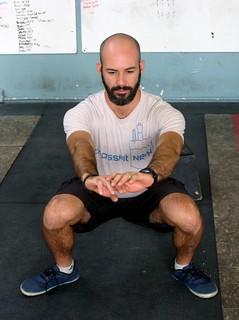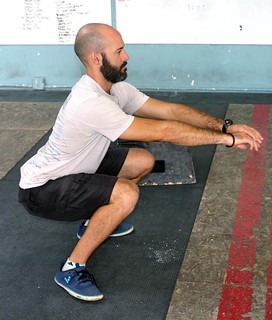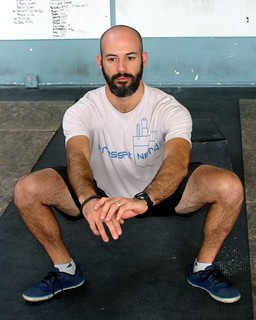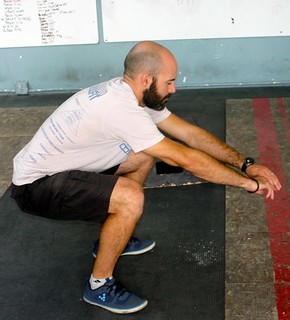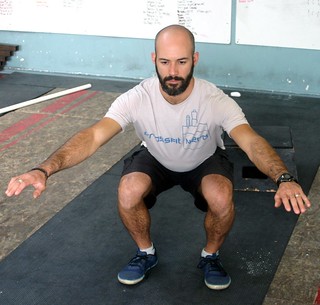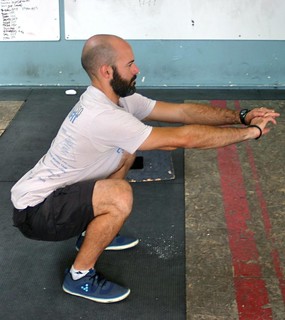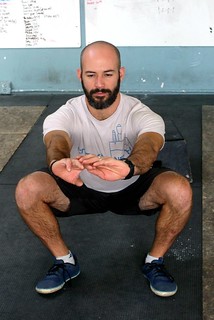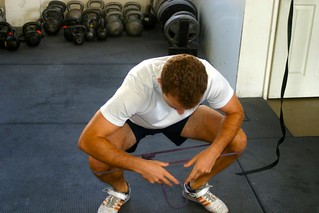Movers and Stabilizers
Friday, October 12, 2012
20 Minutes Mobility: Improving the squat/lifting position
Take a photo of your best squat from the front and the side, then perform each of the following:
Hip Extension with Band
Foam Roll the Legs
Groiners
Ankle Mobility
Posterior Chain Flossing with Band
Assisted Bottom of the Squat
Take an after photo!
Workout for the board!:
‘Isabel’
30 Snatches for time
-10 minute Cap-
Full recovery, then…
1K Row Time Trial
**********************
Below are a few common faults we see in the squat!
The knees are caving and the ankles are collapsed. This is not a stable position and very common for beginner squatters. This is typically related to poor range of motion in the hip capsule.
On the left: Again, a poor range of motion in the hip joint forces the feet to go wide with the toes pointing outward. You can still squat quite a bit of weight from this position, but is not ideal for stability. On the Right: The classic rounded back! Make improving this position a priority.

On the left: The feet are too narrow and the knees are straight forward. The femoral head and the hip are actually impinged in this position. Make sure you allow the hip to work and get those knees out! On the right: This is a technically sound squat, but not very functional! We want to see the torso upright and the hips forward. This is most likely an ankle mobility issue!
********************************
Everyone knows that we do a ton of squats at PCF, literally. I think I can speak for the entire PCF staff when I say you guys are doing amazing and we are seeing unbelievable gains over the last year or so.
I’m going to drop a little bit of knowledge with things I have learned over the past few months working at Evolution Physical Therapy. Your body has two types of muscles; movers and stabilizers. The primary role of movers is to produce the movement; squats, pull ups, push ups, etc. The role of the stabilizers is to assist and stabilize the joints and the spine during movement. By strengthening the stabilizer muscles you give more support to the trunk and joints by limiting and controlling the extra movement we see as coaches during squat work. The most obvious fault I see is knees collapsing internally during the down and up movement of the squat. Next time we do squats, take a look at the athlete next to you and you will see what I am talking about. CrossFit does a great job strengthening all of our major muscle groups and many core/stabilizing muscles but there are still areas; especially our hips, that see instability. The movers are the most prominent muscles in the body, but they cannot function as efficiently as they could if the stabilizing muscles are weak.
Many of you may be feeling tightness and even pain in your hips and knees and this pain is directly related to too much movement and instability with these stabilizer muscles; most notably the gluteus medius and maximus. Poor biomechanics is something we take seriously at PCF and that is why we are trying to hammer home the idea of mobility to all of you. The more you know about this topic and the more you apply it everyday the better you will feel and the better you will perform at the box day in and day out. Strengthening these stabilizer muscles will give you better balance, coordination, power and speed.
I have a few exercises to help strengthen the gluteus medius and maximus muscles but we have not yet made videos to show you . If you feel weak in the bottom of you squat, feel weak getting out of the bottom of the squat, pain in you iliotibial band (IT Band), or pain in your knees come talk to me and I will be happy to show you a couple things I have learned. Have Fun!!
Diso Rocking the perfect squat and Jordan rocking McCoy’s legendary lifting kicks while doing some band work! Watch the video on glute activation if you struggle with getting your knees out.





